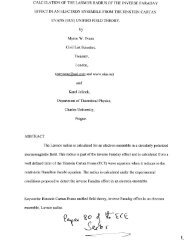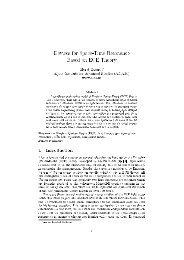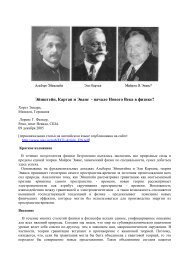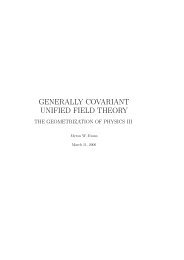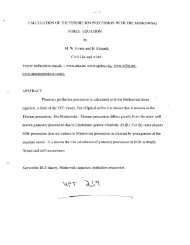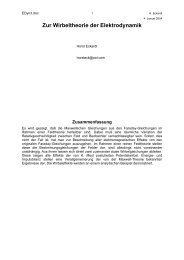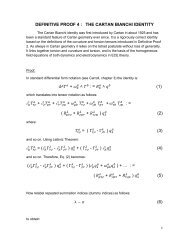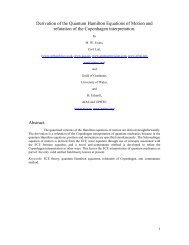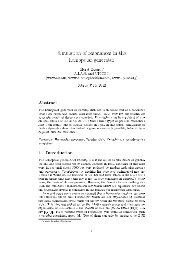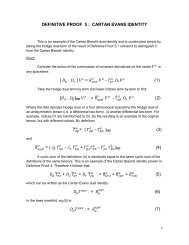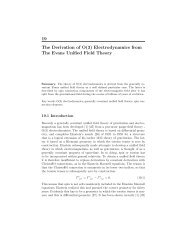Einstein, Cartan and Evans – Start of a New Age in Physics? - Aias.us
Einstein, Cartan and Evans – Start of a New Age in Physics? - Aias.us
Einstein, Cartan and Evans – Start of a New Age in Physics? - Aias.us
You also want an ePaper? Increase the reach of your titles
YUMPU automatically turns print PDFs into web optimized ePapers that Google loves.
ECE Theory, H. Eckardt, L. Felker 09. Dec. 2005<br />
Albert <strong>E<strong>in</strong>ste<strong>in</strong></strong> Elie <strong>Cartan</strong> Myron W. <strong>Evans</strong> 1<br />
<strong>E<strong>in</strong>ste<strong>in</strong></strong>, <strong>Cartan</strong> <strong>and</strong> <strong>Evans</strong> <strong>–</strong><br />
<strong>Start</strong> <strong>of</strong> a <strong>New</strong> <strong>Age</strong> <strong>in</strong> <strong>Physics</strong>?<br />
Horst Eckardt,<br />
Munich, Germany<br />
Laurence G. Felker,<br />
Reno, Nevada, USA<br />
[orig<strong>in</strong>al German article to be published onl<strong>in</strong>e at: http://www.borderl<strong>and</strong>s.de/<strong>in</strong>et.jrnl.php3]<br />
Summary<br />
Although physicists have struggled <strong>in</strong> va<strong>in</strong> for over a half-century to encompass all natural<br />
forces with<strong>in</strong> a unified theory, chemical physicist Myron W. <strong>Evans</strong> has now succeeded.<br />
Based on the fundamental <strong>in</strong>sights <strong>of</strong> Albert <strong>E<strong>in</strong>ste<strong>in</strong></strong> <strong>and</strong> Elie <strong>Cartan</strong>, <strong>Evans</strong>’ theory takes<br />
the geometry <strong>of</strong> space-time itself as the orig<strong>in</strong> <strong>of</strong> all forces <strong>of</strong> Nature. As <strong>E<strong>in</strong>ste<strong>in</strong></strong> attributed<br />
gravitation to the curvature <strong>of</strong> space-time, the new theory attributes electromagnetism to the<br />
torsion or twist<strong>in</strong>g <strong>of</strong> space-time. The possibility <strong>of</strong> reciprocal <strong>in</strong>teractions between gravitation<br />
<strong>and</strong> electromagnetism -- which possibility is denied <strong>in</strong> current ma<strong>in</strong>stream physics -- leads to<br />
predictions <strong>of</strong> new physical effects which could be <strong>us</strong>ed to produce power <strong>and</strong> energy from<br />
space-time.<br />
1 Photograph by Al<strong>in</strong>a Hacikjana
ECE Theory, H. Eckardt, L. Felker 09. Dec. 2005<br />
Introduction<br />
For centuries, physicists <strong>and</strong> philosophers sought a unified description <strong>of</strong> all phenomena <strong>of</strong><br />
Nature. We know today that the world at the sub-microscopic quantum scale behaves very<br />
differently than our familiar macroscopic experience. In particular, theories <strong>of</strong> gravitation<br />
have been irreconcilable with quantum theory. Therefore, one expects that, if gravitation<br />
could be unified with quantum theory, wholly new <strong>in</strong>sights would result. It now appears that<br />
this unification has been achieved, but not <strong>in</strong> the manner expected by previo<strong>us</strong> generations<br />
<strong>of</strong> scientists. This unification predicts fundamental new effects <strong>–</strong> for example, the production<br />
<strong>of</strong> energy (or power) without need for <strong>in</strong>put <strong>of</strong> other primary energy. This prediction, among<br />
others, is creat<strong>in</strong>g great <strong>in</strong>terest <strong>in</strong> pr<strong>of</strong>essional <strong>and</strong> scientific circles. We now review the<br />
orig<strong>in</strong>s <strong>of</strong> this unification.<br />
Albert <strong>E<strong>in</strong>ste<strong>in</strong></strong> <strong>in</strong> 1915 published a theory <strong>of</strong> the gravitational <strong>in</strong>teraction; he called this the<br />
theory <strong>of</strong> General Relativity, <strong>and</strong> today it provides the basis for our underst<strong>and</strong><strong>in</strong>g <strong>and</strong><br />
exploration <strong>of</strong> the cosmos at large. In 1905, <strong>E<strong>in</strong>ste<strong>in</strong></strong> had already produced the theory <strong>of</strong><br />
Special Relativity, which rests upon the well-known postulate <strong>of</strong> “constancy <strong>of</strong> the speed <strong>of</strong><br />
light“ <strong>in</strong> vacuum. Dur<strong>in</strong>g the last thirty years <strong>of</strong> his life, <strong>E<strong>in</strong>ste<strong>in</strong></strong> looked for a still more<br />
comprehensive unified theory which could cover all known natural forces. He spent the years<br />
from approximately 1925 to 1955 <strong>in</strong> this search, but did not reach his desired goal. S<strong>in</strong>ce the<br />
discovery <strong>of</strong> quantum mechanics <strong>in</strong> the 1920’s, the majority <strong>of</strong> physicists b<strong>us</strong>ied themselves<br />
with this, <strong>and</strong> not with General Relativity. The fact that quantum mechanics is consistent<br />
only with Special Relativity, but not with General Relativity, was overlooked or ignored. In<br />
addition, while quantum mechanics is successful <strong>in</strong> describ<strong>in</strong>g the electron sheath <strong>of</strong> atoms;<br />
it is not a suitable theory for the high mass-densities which occur with<strong>in</strong> atomic nuclei.<br />
Other notable progress toward unified theory <strong>in</strong> the 20th century consisted <strong>of</strong> a unification <strong>of</strong><br />
electromagnetism with the weak nuclear force, via an extension <strong>of</strong> the formalism <strong>of</strong> quantummechanics.<br />
Gravitation has rema<strong>in</strong>ed, until today, outside the St<strong>and</strong>ard Model <strong>of</strong> particle<br />
physics.<br />
Elie <strong>Cartan</strong> is less well-known than <strong>E<strong>in</strong>ste<strong>in</strong></strong>. He was a French mathematician who<br />
exchanged ideas with <strong>E<strong>in</strong>ste<strong>in</strong></strong> concern<strong>in</strong>g many details <strong>of</strong> General Relativity. <strong>Cartan</strong>’s<br />
orig<strong>in</strong>al <strong>in</strong>sight was that electromagnetism could be derived, via differential geometry, from<br />
the geometry <strong>of</strong> space-time <strong>–</strong> more or less <strong>in</strong> parallel with <strong>E<strong>in</strong>ste<strong>in</strong></strong>’s <strong>in</strong>sight that gravitation<br />
could be derived from space-time geometry.<br />
A successful unification, however, was not achieved by <strong>Cartan</strong> <strong>and</strong>/or <strong>E<strong>in</strong>ste<strong>in</strong></strong>. The<br />
unification was f<strong>in</strong>ally achieved <strong>in</strong> the year 2003 by Myron <strong>Evans</strong> who, tra<strong>in</strong>ed as a chemical<br />
physicist, brought fresh <strong>in</strong>sight to the problem. <strong>Evans</strong> held several academic pr<strong>of</strong>essorships<br />
<strong>in</strong> Engl<strong>and</strong> <strong>and</strong> the USA, before he was forced to withdraw beca<strong>us</strong>e <strong>of</strong> his unorthodox views,<br />
<strong>and</strong> he now works as a “private researcher“ <strong>in</strong> his homel<strong>and</strong> <strong>of</strong> Wales. From there, he<br />
conducts the “Alpha Institute for Advanced Study“ (AIAS), which presents his ideas to the<br />
public as a world-wide team or work<strong>in</strong>g-group. A popular-scientific presentation is <strong>in</strong> [3].<br />
Recently concentrat<strong>in</strong>g its work on energy production from the vacuum -- a topic which<br />
established science avoids <strong>–</strong> the AIAS website generates large <strong>in</strong>terest, as shown by the<br />
steady <strong>in</strong>crease <strong>in</strong> web-page statistics on the AIAS site [4]. Many well-known universities <strong>and</strong><br />
research establishments world-wide have visited these pages.<br />
1 The four natural forces<br />
To underst<strong>and</strong> the importance <strong>of</strong> unification, one m<strong>us</strong>t start with knowledge <strong>of</strong> the quantities<br />
be<strong>in</strong>g unified. It is widely accepted <strong>in</strong> physics that all <strong>in</strong>teractions <strong>in</strong> Nature are<br />
manifestations <strong>of</strong> four fundamental forces. . We characterize these briefly as follows:<br />
1. The seem<strong>in</strong>gly separate force-fields generated by electrostatic charge <strong>and</strong><br />
magnetism were united <strong>in</strong> the 19th century, largely by Maxwell, <strong>in</strong>to what is now<br />
called electromagnetism, or the electromagnetic field.
ECE Theory, H. Eckardt, L. Felker 09. Dec. 2005<br />
2. The weak nuclear force is responsible for radioactive decay. Accord<strong>in</strong>g to the<br />
St<strong>and</strong>ard Model <strong>of</strong> elementary particle physics, the weak <strong>in</strong>teraction is mediated by<br />
the W- <strong>and</strong> Z-bosons, which are “virtual particles“. Neutr<strong>in</strong>os also are known to be<br />
<strong>in</strong>volved <strong>in</strong> the weak <strong>in</strong>teraction. It has been shown that the weak force is essentially<br />
the same as electromagnetism at very high energies. Th<strong>us</strong>, these two forces are said<br />
to be “already united“.<br />
3. The strong nuclear force holds protons <strong>and</strong> neutrons together. It is carried by gluons<br />
<strong>and</strong> quarks <strong>in</strong> comb<strong>in</strong>ation, although direct experimental pro<strong>of</strong> <strong>of</strong> their existence was<br />
not achieved until recently.<br />
4. Gravitation is the fourth fundamental force, but it does not fit with the theoretical<br />
picture <strong>of</strong> the other three, s<strong>in</strong>ce it is regarded (after <strong>E<strong>in</strong>ste<strong>in</strong></strong>'s General Relativity<br />
theory) as the curvature <strong>of</strong> space-time, which does not correspond to a classical force<br />
term. On the other h<strong>and</strong>, General Relativity today has been well-tested<br />
experimentally, so that nobody doubts its validity.<br />
2 Unification<br />
If a unified description <strong>and</strong> formalism could be given for these four very different forces,<br />
many new theoretical <strong>in</strong>sights <strong>and</strong> practical applications would result. In addition, mutuallyreciprocal<br />
<strong>in</strong>teractions -- which today’s ma<strong>in</strong>stream physics does not recognize -- could then<br />
be predicted <strong>and</strong> <strong>us</strong>ed. As we will see later, such <strong>in</strong>teractions open new possibilities for<br />
power generation. In view <strong>of</strong> the urgent global energy crisis, this might be the most important<br />
application <strong>of</strong> such a unification.<br />
The first three fundamental forces concern quantum physics (the world “<strong>in</strong> the small“), while<br />
the fourth force (gravitation) applies on all scales, <strong>in</strong>clud<strong>in</strong>g cosmic orders <strong>of</strong> magnitude.<br />
Therefore, the underly<strong>in</strong>g fundamental problem is to unify General Relativity with quantum<br />
mechanics. Conventional science has explored essentially three different pathways which<br />
might achieve this result:<br />
1. Br<strong>in</strong>g<strong>in</strong>g general relativity <strong>in</strong>to quantum physics. The <strong>in</strong>surmountable difficulty here is<br />
that time <strong>in</strong> quantum physics is treated as a unique cont<strong>in</strong>uo<strong>us</strong> parameter, which is<br />
<strong>in</strong>commensurate with the quantized coord<strong>in</strong>ates <strong>of</strong> distance (or spatial displacement).<br />
2. Quantization <strong>of</strong> General Relativity. But the mathematical formalism for this approach<br />
is th<strong>us</strong> far <strong>in</strong>concl<strong>us</strong>ive, <strong>and</strong> unable to make reference to experimental tests.<br />
3. Invention <strong>of</strong> a totally new theory, from which the others follow. The vario<strong>us</strong> “str<strong>in</strong>g<br />
theories” are examples, but they require un-physical high-dimensional spaces (N>10),<br />
<strong>and</strong> have not produced testable predictions.<br />
The solution comes, surpris<strong>in</strong>gly, <strong>in</strong> an unexpected way. By extend<strong>in</strong>g the <strong>E<strong>in</strong>ste<strong>in</strong></strong> theory<br />
along the l<strong>in</strong>es first suggested by <strong>Cartan</strong>, <strong>Evans</strong> shows that all four fundamental forces are<br />
derivable from one extended theory. This represents the long-sought Unified Field Theory.<br />
<strong>Evans</strong>’ approach does not exactly follow any <strong>of</strong> the three above-mentioned pathways,<br />
although it is closest to the third one <strong>in</strong> the list.<br />
3 Basis for <strong>Evans</strong>’ theory<br />
To underst<strong>and</strong> the basis <strong>of</strong> <strong>Evans</strong>’ theory, we m<strong>us</strong>t review the start<strong>in</strong>g-po<strong>in</strong>t <strong>of</strong> <strong>E<strong>in</strong>ste<strong>in</strong></strong>’s<br />
relativity theory. <strong>E<strong>in</strong>ste<strong>in</strong></strong> postulated that the presence <strong>of</strong> a massive body or an energy<br />
distribution <strong>in</strong> space (which are really <strong>in</strong>terchangeable, accord<strong>in</strong>g to the famo<strong>us</strong> formula<br />
E=mc 2 ) changes the geometry <strong>of</strong> space. Viewed from right-angles with<strong>in</strong> a Euclidean<br />
coord<strong>in</strong>ate system, it “creates” a curvature <strong>of</strong> space (or, more accurately, space-time). One<br />
can write this directly as a formula:<br />
R = k T<br />
In which R designates the (tensor <strong>of</strong>) curvature, T the (tensor <strong>of</strong>) energy-momentum density,<br />
<strong>and</strong> k is a proportionality constant. The left side <strong>of</strong> this formula is geometry, the right side is
ECE Theory, H. Eckardt, L. Felker 09. Dec. 2005<br />
physics. <strong>E<strong>in</strong>ste<strong>in</strong></strong> th<strong>us</strong> <strong>us</strong>ed the geometry <strong>of</strong> curvil<strong>in</strong>ear coord<strong>in</strong>ates, which goes back to the<br />
mathematician Riemann. This formula implies that space-time (i.e. the three space<br />
coord<strong>in</strong>ates, <strong>and</strong> time as the fourth coord<strong>in</strong>ate) is a 4-dimensional cont<strong>in</strong>uum (or manifold)<br />
whose curvature we perceive as a force (namely gravitation).<br />
Notably, <strong>E<strong>in</strong>ste<strong>in</strong></strong>’s formula did not exploit all possible characteristics <strong>of</strong> Riemann’s geometry.<br />
It turns out that R describes only the <strong>in</strong>tr<strong>in</strong>sic curvature <strong>of</strong> the manifold; <strong>in</strong> other words, it is<br />
limited to describ<strong>in</strong>g vectors whose po<strong>in</strong>t-to-po<strong>in</strong>t variation lies entirely with<strong>in</strong> the manifold<br />
(see Fig. 1A).<br />
1<br />
A<br />
3<br />
2<br />
B<br />
Spacetime<br />
Curvature<br />
Spacetime<br />
Sp<strong>in</strong>n<strong>in</strong>g<br />
A) Curvature<br />
B) Torsion<br />
Fig. 1: Curvature <strong>and</strong> Torsion<br />
In contrast to this, <strong>Cartan</strong> employed considerations <strong>of</strong> extr<strong>in</strong>sic curvature. This means that<br />
vectors are also allowed to vary with<strong>in</strong> (<strong>and</strong> normal to) the plane tangent to the manifold at<br />
any po<strong>in</strong>t (see Fig. 1B). <strong>Cartan</strong> showed that the extr<strong>in</strong>sic curvature <strong>of</strong> space-time could be<br />
taken to represent electromagnetism as described by the Maxwell equations. Unfortunately,<br />
<strong>E<strong>in</strong>ste<strong>in</strong></strong>’s <strong>us</strong>e <strong>of</strong> the mathematical concept <strong>of</strong> tensors made the relation to <strong>Cartan</strong>’s concept<br />
<strong>of</strong> geometry unclear. <strong>Cartan</strong> <strong>us</strong>ed the so-called “tetrad” to represent the manifold’s extr<strong>in</strong>sic<br />
curvature. In the 3-dimensional case, this reduces to a Cartesian-coord<strong>in</strong>ate “triad”, which<br />
moves along with a po<strong>in</strong>t <strong>in</strong> space. More exactly said, the tetrad specifies a tangent space at<br />
each po<strong>in</strong>t <strong>of</strong> the Riemann manifold. In this way, one ma<strong>in</strong>ta<strong>in</strong>s at each po<strong>in</strong>t a Euclidean<br />
tangent space (a so-called fiducial space), which greatly simplifies the description <strong>and</strong><br />
visualization <strong>of</strong> physical processes (Fig. 2).<br />
Fig.2: Tangent plane at a curved surface
ECE Theory, H. Eckardt, L. Felker 09. Dec. 2005<br />
Despite the value <strong>of</strong> <strong>E<strong>in</strong>ste<strong>in</strong></strong>’s <strong>and</strong> <strong>Cartan</strong>’s <strong>in</strong>sights, a united theory could not yet be<br />
formulated, beca<strong>us</strong>e experimental <strong>in</strong>dications <strong>of</strong> how to extend Maxwell’s theory <strong>in</strong> a manner<br />
consistent with General Relativity were still miss<strong>in</strong>g. The crucial connection was found by<br />
<strong>Evans</strong> around 1990 <strong>in</strong> the sp<strong>in</strong> field or B (3) field.<br />
The decisive empirical effect -- the Inverse Faraday Effect (IFE), i.e. the magnetization <strong>of</strong><br />
matter by a beam <strong>of</strong> circular-polarized electromagnetic radiation, first observed<br />
experimentally <strong>in</strong> 1964 -- could not be expla<strong>in</strong>ed by Maxwell-Heaviside electrodynamics,<br />
except by <strong>in</strong>troduc<strong>in</strong>g an ad-hoc material property tensor.<br />
However, <strong>Evans</strong> <strong>in</strong> 1992 was able to derive the IFE directly from first pr<strong>in</strong>ciples (generallycovariant<br />
unified field theory, which <strong>in</strong>cludes general relativity), <strong>and</strong> thereby <strong>in</strong>ferred the<br />
existence <strong>of</strong> a previo<strong>us</strong>ly unknown magnetic field component -- the B(3) field.<br />
B(3) is, <strong>in</strong>formally, a general-relativistic correction to classical electrodynamics, somewhat<br />
analogo<strong>us</strong> to the general-relativistic correction to <strong>New</strong>tonian gravitation needed to expla<strong>in</strong><br />
the perihelion-advance <strong>of</strong> Mercury.<br />
The <strong>in</strong>dex numbers <strong>–</strong> (1), (2) <strong>and</strong> (3) -- here refer to the so-called circular basis; <strong>and</strong> the<br />
polarization directions B (1) <strong>and</strong> B (2) refer to the directions <strong>of</strong> transverse polarization <strong>of</strong> the<br />
field. Th<strong>us</strong> a polarization <strong>in</strong>dex m<strong>us</strong>t be <strong>in</strong>serted <strong>in</strong>to the Maxwell equations. This polarization<br />
<strong>in</strong>dex corresponds to the tetrad vectors q a <strong>in</strong> Fig. 2. F<strong>in</strong>ally, this leads <strong>Evans</strong> to postulate<br />
that the geometrical representation <strong>of</strong> the electromagnetic vector-potential A should be a<br />
follows:<br />
A a = A (0) q a<br />
where A is the 4x4-matrix <strong>of</strong> the complete electromagnetic potential, <strong>and</strong> A (0) is a<br />
proportionality factor. The electric <strong>and</strong> magnetic fields (comb<strong>in</strong>ed <strong>in</strong>to the tensor F a <strong>of</strong> the<br />
total electromagnetic field) then emerge directly from <strong>Cartan</strong>’s expression for the torsion T a :<br />
F a = A (0) T a<br />
In this formalism, electrodynamics is completely attributed to the geometrical torsion <strong>of</strong><br />
space-time. The complete picture, unify<strong>in</strong>g electromagnetism with gravitation, requires both<br />
Riemann curvature <strong>and</strong> <strong>Cartan</strong> torsion. The <strong>in</strong>tr<strong>in</strong>sic curvature determ<strong>in</strong>es gravitation, <strong>and</strong><br />
the extr<strong>in</strong>sic curvature (i.e., torsion) determ<strong>in</strong>es the electromagnetic field. This is described <strong>in</strong><br />
detail by suitable field equations <strong>in</strong> form <strong>of</strong> Riemann-<strong>Cartan</strong> geometry. This theory is now<br />
called <strong>E<strong>in</strong>ste<strong>in</strong></strong>-<strong>Cartan</strong>-<strong>Evans</strong> (ECE) theory, after the names <strong>of</strong> its pr<strong>in</strong>cipal authors.<br />
4 Unification with strong <strong>and</strong> weak forces<br />
Still to be described is how the rema<strong>in</strong><strong>in</strong>g two fundamental forces are represented <strong>in</strong> the ECE<br />
theory.<br />
If one analyzes the equations <strong>of</strong> the theory, it is noticeable that it is formulated for the tangent<br />
space <strong>of</strong> the Riemann manifold. The number <strong>of</strong> basis vectors <strong>of</strong> this space can be selected<br />
freely, it needs not be four-dimensional. Thereby the possibility is <strong>of</strong>fered <strong>of</strong> select<strong>in</strong>g such<br />
bases which are suitable for the description <strong>of</strong> quantized action (e.g. electron sp<strong>in</strong>).<br />
Furthermore <strong>Evans</strong> derived from <strong>Cartan</strong> geometry a wave equation, which is <strong>in</strong> pr<strong>in</strong>ciple a<br />
nonl<strong>in</strong>ear eigenvalue equation. Under certa<strong>in</strong> approximation assumptions. this equation<br />
becomes l<strong>in</strong>ear <strong>and</strong> predicts discrete stable states. Those are the “quanta” <strong>of</strong> energymomentum<br />
<strong>in</strong> quantum mechanics. All quantum-mechanical theories, <strong>in</strong> particular Dirac’s<br />
electron theory, <strong>and</strong> the strong <strong>and</strong> weak <strong>in</strong>teractions, can be deduced <strong>in</strong> this way as special<br />
cases <strong>of</strong> the ECE theory.<br />
If we compare this result with the three conventional paths to unification referred to above, it<br />
is noticeable that none <strong>of</strong> these was actually <strong>us</strong>ed. The new theory predicts quantum effects<br />
without assum<strong>in</strong>g them (as a postulate) from the beg<strong>in</strong>n<strong>in</strong>g. The first two forces<br />
(electromagnetism <strong>and</strong> weak force) are comb<strong>in</strong>ed, the third <strong>and</strong> fourth turn out to be<br />
derivable from other considerations. In short, there are no truly “fundamental forces” beca<strong>us</strong>e<br />
they all emerge from geometry!
ECE Theory, H. Eckardt, L. Felker 09. Dec. 2005<br />
5 Implications for quantum physics<br />
The ma<strong>in</strong> implication is that quantum theory <strong>in</strong> its current form is not a fundamental<br />
description <strong>of</strong> Nature. In particular, the Heisenberg <strong>in</strong>terpretation <strong>and</strong> the Correspondence<br />
pr<strong>in</strong>ciple are <strong>in</strong>correct. The ECE version <strong>of</strong> quantum physics rests upon a classical, fully<br />
determ<strong>in</strong>istic basis; quantum <strong>in</strong>determ<strong>in</strong>acy plays no role. Nevertheless the equations <strong>of</strong><br />
quantum mechanics (for <strong>in</strong>stance the Schroed<strong>in</strong>ger equation) are correct <strong>and</strong> describe<br />
classical statistical processes. It would be a mark aga<strong>in</strong>st ECE theory if it did not predict this<br />
result, beca<strong>us</strong>e the equations <strong>of</strong> quantum mechanics are experimentally verified a tho<strong>us</strong><strong>and</strong>fold.<br />
<strong>Evans</strong> also argues that the Heisenberg Uncerta<strong>in</strong>ty relation arose only by a<br />
misunderst<strong>and</strong><strong>in</strong>g, <strong>and</strong> is not j<strong>us</strong>tifiable. All physical mass-po<strong>in</strong>ts <strong>of</strong> a field theory are actually<br />
densities -- i.e. quanta <strong>of</strong> matter-energy spread over a volume <strong>of</strong> space. Thereby the Planck<br />
quantum <strong>of</strong> action is to be divided by the volume, for <strong>in</strong>stance, <strong>of</strong> the measur<strong>in</strong>g <strong>in</strong>strument <strong>in</strong><br />
which two complementary variables (e.g. position <strong>and</strong> momentum) are measured. The result<br />
can become arbitrarily small, i.e. the uncerta<strong>in</strong>ty can be reduced to powers <strong>of</strong> ten smaller<br />
than previo<strong>us</strong>ly believed. An elementary particle, therefore, is neither excl<strong>us</strong>ively a wave, nor<br />
excl<strong>us</strong>ively a particle, but possesses characteristics <strong>of</strong> both at the same time.<br />
This sounds fantastic as a theory <strong>of</strong> physics, but exactly that was measured already some<br />
years ago [5]. The experimental refutation <strong>of</strong> the uncerta<strong>in</strong>ty relation was accomplished by<br />
ma<strong>in</strong>stream physics.<br />
Electron paths<br />
Solenoid<br />
Electron<br />
source<br />
Double<br />
Holes<br />
Screen<br />
Fig.3: The Aharonov Bohm effect<br />
As a further example <strong>of</strong> an effect which was previo<strong>us</strong>ly difficult to expla<strong>in</strong>, we consider the<br />
Aharonov Bohm effect (Fig. 3). Two electron beams are diffracted by a double gap, at the<br />
screen, a typical <strong>in</strong>terference pattern is produced. In the diffraction zone is a closed toroidal<br />
coil. The magnetic field is circularly closed <strong>and</strong> th<strong>us</strong> rema<strong>in</strong>s with<strong>in</strong> the coil. If one now<br />
switches on <strong>and</strong> <strong>of</strong>f the magnetic field, <strong>in</strong> each case two different <strong>in</strong>terference patterns result.<br />
The closed magnetic field th<strong>us</strong> has an effect on the electron beams, although these are not<br />
<strong>in</strong> direct contact with the coil. This appears to be a quantum-mechanical “action at a<br />
distance“, which has given rise to many conf<strong>us</strong>ions <strong>and</strong> unsound speculations.<br />
This problem is treated <strong>in</strong> ECE theory as follows. The magnetic field <strong>of</strong> the coil creates a<br />
space-time “vortex” (due to its torsion) which extends <strong>in</strong>to the space outside <strong>of</strong> the coil itself.<br />
The pull<strong>in</strong>g effect <strong>of</strong> this vortex (i.e. the effect <strong>of</strong> vector-potential A) is then able to <strong>in</strong>fluence
ECE Theory, H. Eckardt, L. Felker 09. Dec. 2005<br />
the electron beams. Th<strong>us</strong>, the apparent “action at a distance” is reduced formally to local,<br />
ca<strong>us</strong>al determ<strong>in</strong>istic effect.<br />
<strong>Evans</strong> po<strong>in</strong>ts out that torsion is always accompanied by curvature. S<strong>in</strong>ce curvature is<br />
manifested as gravitational mass, it follows that the sp<strong>in</strong> <strong>of</strong> all elementary particles m<strong>us</strong>t<br />
contribute a component to their gravitational mass. From the neutr<strong>in</strong>o one knows this<br />
already experimentally, even if the st<strong>and</strong>ard model fails here. Also photons m<strong>us</strong>t possess a<br />
gravitational mass, which is extremely small, however, <strong>and</strong> is situated below current<br />
detection limits.<br />
6 Implications for technology<br />
Typically, new theories lead to practical applications only after many years. In the case <strong>of</strong><br />
nuclear f<strong>us</strong>ion, the hope <strong>of</strong> produc<strong>in</strong>g <strong>us</strong>eful power for society’s <strong>us</strong>e rema<strong>in</strong>s unfulfilled even<br />
after 50 years. In contrast, the ECE theory suggests direct applications <strong>in</strong> diverse fields -- <strong>in</strong><br />
particular, the urgent question <strong>of</strong> energy production.<br />
The possibility <strong>of</strong> a new energy source arises from the reciprocal <strong>in</strong>teraction between<br />
gravitation <strong>and</strong> electromagnetism. Accord<strong>in</strong>g to current st<strong>and</strong>ard theory (Maxwell equations)<br />
this <strong>in</strong>teraction is not possible.<br />
However, the ECE theory predicts that a gravitational field is always connected with an<br />
electrical field, <strong>and</strong> vice-versa [6]; this might be called “electrogravitics”. The effect has been<br />
known empirically for decades, <strong>of</strong> course, but until now has lacked a quantitative description.<br />
That is now possible with assistance <strong>of</strong> the ECE theory. This application should <strong>in</strong>terest the<br />
aircraft <strong>and</strong> space <strong>in</strong>d<strong>us</strong>tries greatly.<br />
In the area <strong>of</strong> electrical generators, the unipolar generator awaited an adequate explanation<br />
s<strong>in</strong>ce its <strong>in</strong>vention by Faraday <strong>in</strong> 1831. This is now completely expla<strong>in</strong>able [7]. Similarly as<br />
with the Aharonov Bohm effect, the torsion <strong>of</strong> space-time m<strong>us</strong>t be considered. In this case it<br />
is created due to the mechanical rotation.<br />
The most <strong>in</strong>terest<strong>in</strong>g technical application <strong>in</strong>volves the extraction <strong>of</strong> energy directly from<br />
space-time. One m<strong>us</strong>t underst<strong>and</strong> this as a resonance effect. First the equations <strong>of</strong> ECE<br />
theory show that matter can “transduce” energy from the surround<strong>in</strong>g space-time (one<br />
sometimes speaks also <strong>of</strong> “vacuum”). To accomplish this <strong>in</strong> practice requires that one<br />
fabricate a suitable configuration <strong>of</strong> space-time, e.g. a skillful mechanical or electromagnetic<br />
arrangement. The configuration m<strong>us</strong>t be so arranged that a resonant excitation <strong>of</strong> the<br />
material takes place. One knows from forced mechanical oscillations that, with suitable<br />
excitation frequency, large amounts <strong>of</strong> power can be transferred to or from the oscillat<strong>in</strong>g<br />
system.<br />
Probably many “overunity” <strong>in</strong>ventions on the alternative power scene function this way. In<br />
these cases, the <strong>in</strong>ventors found the resonance mechanism by accident. Therefore, some<br />
experiments are not repeatable, beca<strong>us</strong>e the fundamental mechanism <strong>and</strong> critical system<br />
parameters, which led to the desired result, are not actually known.<br />
The ECE theory makes it possible to calculate these parameters exactly. The AIAS group is<br />
presently study<strong>in</strong>g the excitation mechanism, via numerical solution <strong>of</strong> the ECE equations.<br />
Experimentally the foc<strong>us</strong> is on resonance excitation <strong>in</strong> electrical circuits. If one can obta<strong>in</strong><br />
power <strong>in</strong> this way, mechanically mov<strong>in</strong>g parts (as <strong>in</strong> generators) are not required; <strong>and</strong> due to<br />
the smallness <strong>of</strong> the source, each electrical appliance could, <strong>in</strong> pr<strong>in</strong>ciple, be fitted with its<br />
own power supply. The basic components would be cascadeable up to power station size.<br />
A f<strong>in</strong>al application is <strong>in</strong> medical technology. Nuclear magnetic-resonance (NMR) tomography<br />
requires very high magnetic fields, which forces a correspond<strong>in</strong>gly complex design <strong>and</strong><br />
construction. Instead one could <strong>us</strong>e the Inverse Faraday Effect (described above) to<br />
generate the required magnetic fields <strong>in</strong> the patient. This requires only electromagnetic<br />
radiation <strong>in</strong> the radio-frequency range. Large solenoid coils are then not required, <strong>and</strong> the<br />
NMR apparat<strong>us</strong> could be built substantially smaller <strong>and</strong> cheaper.
ECE Theory, H. Eckardt, L. Felker 09. Dec. 2005<br />
7 Implications for cosmology<br />
The ECE theory also has implications for astrophysics <strong>and</strong> cosmology. Expansion <strong>of</strong> the<br />
universe is conventionally said to be governed by Hubble’s Law, which predicts that galaxies<br />
move away from <strong>us</strong> all the faster, the further they are distant from <strong>us</strong>. This is based on the<br />
red shift <strong>of</strong> starlight from the reced<strong>in</strong>g galaxies.<br />
However, astronomers have recently found red-shift fluctuations which cannot be reconciled<br />
with Hubble’s Law, although this is not publicly disc<strong>us</strong>sed. The ECE theory can expla<strong>in</strong> these<br />
deviations easily. One can translate the ECE equations <strong>in</strong>to a dielectric model. The<br />
reciprocal effect between radiation <strong>and</strong> gravitation is described there<strong>in</strong> by <strong>in</strong>troduc<strong>in</strong>g a<br />
complex-valued dielectric constant. This leads to predictions <strong>of</strong> refraction <strong>of</strong> light <strong>and</strong><br />
absorption. In areas <strong>of</strong> the universe with high mass-density, the dielectric constant is larger<br />
than <strong>in</strong> areas <strong>of</strong> low mass -density. The absorption <strong>of</strong> energy with<strong>in</strong> these areas leads to an<br />
<strong>in</strong>creased red shift. Such a model goes far beyond the Hubble model.<br />
In <strong>Evans</strong>’ theory, the cosmic background radiation accounts for absorbed radiation energy,<br />
<strong>and</strong> is not seen as evidence for the Big Bang, which does not occur <strong>in</strong> this model. Instead<br />
there are exp<strong>and</strong><strong>in</strong>g <strong>and</strong> contract<strong>in</strong>g zones <strong>of</strong> the universe adjacent to each other.<br />
8 Summary<br />
The ECE theory describes a unification <strong>of</strong> the four fundamental forces, <strong>and</strong> their reciprocal<br />
<strong>in</strong>teractions, <strong>in</strong> a simple unorthodox way. All physics becomes reduced to geometry. The<br />
quantum theory is placed on a ca<strong>us</strong>al determ<strong>in</strong>istic basis, while statistical description <strong>of</strong><br />
processes on the atomic level is preserved.<br />
The important po<strong>in</strong>ts <strong>of</strong> the ECE theory are the follow<strong>in</strong>g:<br />
1. Space-time is completely specified by curvature <strong>and</strong> torsion. All physics can be<br />
derived, via differential geometry, from these underly<strong>in</strong>g primordial qualities <strong>of</strong> spacetime.<br />
2. Curvature is the basis <strong>of</strong> gravitation, <strong>and</strong> torsion is the basis <strong>of</strong> electromagnetism.<br />
Also, torsion implies curvature, <strong>and</strong> vice-versa.<br />
3. The ECE theory is mathematically based on differential geometry. It relies excl<strong>us</strong>ively<br />
on ca<strong>us</strong>al connections <strong>and</strong> no stochastic processes.<br />
4. The ECE theory rests on three postulates: the curvature postulate <strong>of</strong> <strong>E<strong>in</strong>ste<strong>in</strong></strong> <strong>and</strong> the<br />
two torsion postulates <strong>of</strong> <strong>Evans</strong> with<strong>in</strong> the electromagnetic sector.<br />
5. The <strong>in</strong>sights <strong>of</strong> <strong>E<strong>in</strong>ste<strong>in</strong></strong> are even more penetrat<strong>in</strong>g than they were believed to be at<br />
first. Specifically, <strong>E<strong>in</strong>ste<strong>in</strong></strong>’s views that “all physics is geometry” <strong>and</strong> that “quantum<br />
mechanics is <strong>in</strong>complete” are correct.<br />
6. The Copenhagen <strong>in</strong>terpretation <strong>of</strong> quantum mechanics is <strong>in</strong>correct; the abstract<br />
space <strong>of</strong> quantum theory is the tangent space <strong>of</strong> the general relativity.<br />
7. The coupl<strong>in</strong>g <strong>of</strong> electrodynamics with gravitation leads to a large number <strong>of</strong> new<br />
applications.<br />
8. In cosmology, there is neither a Hubble Law, nor a Big Bang.<br />
These ideas are difficult for established university scientists to digest without fundamentally<br />
re-orient<strong>in</strong>g themselves. The <strong>Evans</strong> theory will receive strong impet<strong>us</strong> for further<br />
development if it actually succeeds open<strong>in</strong>g new energy sources. Then these ideas will<br />
become generally accepted either with or without the support <strong>of</strong> universities <strong>and</strong> research<br />
<strong>in</strong>stitutes.
ECE Theory, H. Eckardt, L. Felker 09. Dec. 2005<br />
9 References<br />
[1] http://www.aias.<strong>us</strong>, http://www.atomicprecision.com<br />
[2] Myron W. <strong>Evans</strong>, Generally Covariant Unified Field Theory, Part 1. Abramis, 2005, ISBN<br />
1-84549-054-1<br />
[3] L.G. Felker, The <strong>Evans</strong> Equations <strong>of</strong> Unified Field Theory, prepr<strong>in</strong>t on http://www.aias.<strong>us</strong><br />
[4] www.aias.<strong>us</strong>/weblogs/log.html<br />
[5]http://en.wikipedia.org/wiki/Afshar_experiment,<br />
http://www.aias.<strong>us</strong>/Comments/comments01022005.html<br />
[6] P.K. Anastasovski et al., Development Of The <strong>Evans</strong> Wave Equation In The Weak Field<br />
Limit: The Electrogravitic Equation, prepr<strong>in</strong>t 2003<br />
(http://www.aias.<strong>us</strong>/pub/electrogravitic2.pdf)<br />
[7] F. Amador et al., Explanation <strong>of</strong> the Faraday Disc Generator <strong>in</strong> the <strong>Evans</strong> Unified Field<br />
Theory, paper 43 <strong>of</strong> the unified field series, 2005 (http://www.aias.<strong>us</strong>/pub/a43rdpaper.pdf)<br />
[Translator’s Note: I have tried to faithfully render the authors’ orig<strong>in</strong>al ideas <strong>in</strong>to English, but<br />
do not necessarily endorse (nor disagree with) the views expressed or disc<strong>us</strong>sed here<strong>in</strong>.]



